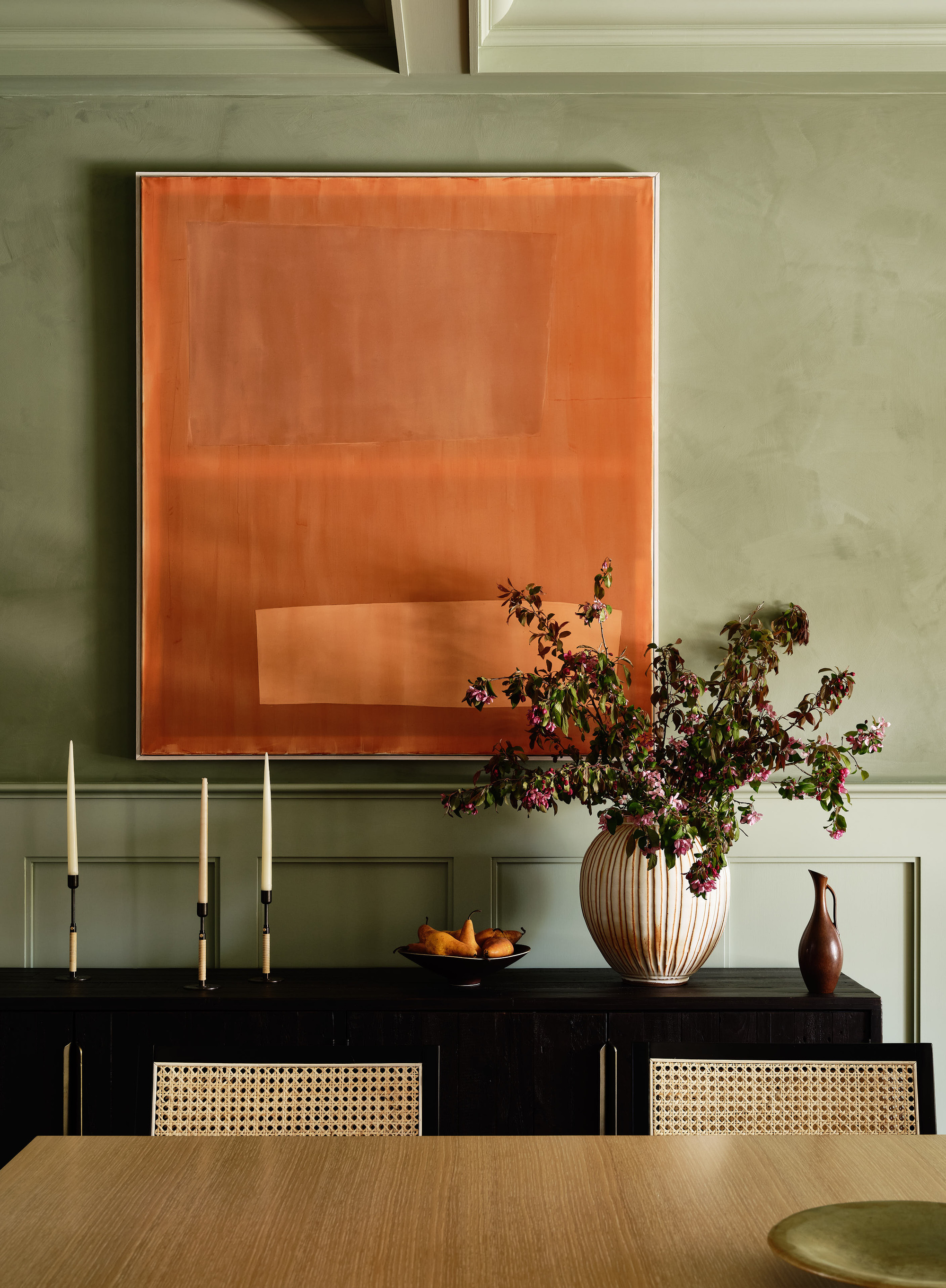A Complete Guide to Color Drenching a Room — The Tone-On-Tone Paint Style Taking Over Our Homes
Soaking a space in all one color may appear to be a bold statement but it actually helps create soothing schemes that feel more spacious


I love color — I do — but when it comes to my own home, I tend to stick to more neutral hues. That's largely because choosing different colors that will work together is much harder than it looks, and I have a certain aversion to accent walls. But I think I may have found a solution — color drenching.
Color drenching is a decorating trend that's currently taking over the design world — and our rooms. The technique sees us covering every surface in a space (yes, the walls, ceilings, cabinetry, trims, baseboards and even floors if you're feeling bold) in the same single paint color, creating monochromatic spaces that draw you in and delight the senses.
But it's about more than just painting ceilings and walls the same color. 'Color drenching is like a great big hug of color in a room,' says Whitney Romanoff, owner and principal designer of Northwest Arkansas-based studio Meet West. 'It sets a clear vibe and draws you into a space with the cocooning effect of a single color.'
Not only does it cut down on your paint color decisions, but it's also a more cost-effective approach when compared to wallpapering, or painting a room with contrasting colors. Convinced? I know I am. But I also know it can't be as simple as it seems, so I asked the experts for everything you need to know about color drenching to ensure you room is filled with impact rather than feeling flat.
What is color drenching?

As previously described, color drenching is a paint trend where you paint your ceiling, walls, trim, cabinetry, and baseboards all the same color — every surface in one single hue. It can also extend to the choice of furnishings and decor, creating a cohesive and monochromatic effect that can dramatically influence the way a room feels.
It can also be used to establish different areas within the home, signifying specific activities or atmospheres designated to that space. 'When you step into this bedroom from the warm white of the social space of this home, you feel like your shoulders can drop a little bit, you can be quiet, and retreat into your own thoughts,' says Whitney Romanoff, describing her decision to paint the bedroom above in a deep oxblood tone. 'The color drenching signals you've entered a different, private domain.'
What is the benefit of color drenching?

Apart from the fact that color drenching means you only have to pick one paint color for a space, and you avoid having to tape the ceiling and trim or doing detailed work like cutting in, there are also plenty of aesthetic benefits to color drenching a space.
The Livingetc newsletters are your inside source for what’s shaping interiors now - and what’s next. Discover trend forecasts, smart style ideas, and curated shopping inspiration that brings design to life. Subscribe today and stay ahead of the curve.
For one, it's a great way to make unattractive aspects of your room — think aircon units, attic doors or vents — virtually disappear, but it can also dramatically transform the way you feel in a space.
'I think people are tired of the typical use of color on walls with high-contrast trims and baseboards and the same predictable white ceiling decorating,' says Whitney. 'That white trim also cuts off the eye and is extra information to process, taking away from the more interesting details of the room.' Remove that contrast, and you're left with a space that feels more soothing to eye, and actually makes architectural details feel more defined.
It's also not as overwhelming as you may originally expect. 'When you color drench a space it both maximizes and minimizes the color,' explains Susana Simonpietri, creative director of Brooklyn-based architecture firm, Chango. 'When a room is monochromatic color scheme, you are making a bold design decision that can create a lot of impact, yet is also normalizes the color, giving it a more neutral feel.' And thus, soothing.
What colors are best for color drenching?

Just the same as when it comes to picking any other paint colors for your home, you should always be led by what you like. Considering it will make up a large part of the final design, it's important to choose a color you won't get sick of. Light or dark — the best color for drenching is one you love. And the designers I spoke to agree.
'My client's husband took a back seat on the design decisions for the whole house, but for his home office he wanted his favorite happy color — yellow,' explains Cecilia Casagrande, founder of Boston-based interior design firm Casagrande Studio. 'So I drenched the walls, trim and ceiling in 'Hay' by Farrow & Ball and the bookcases in 'India Yellow' by Farrow & Ball for a contrast.'
They also say you shouldn't be afraid to embrace dark color schemes. Whitney Romanoff says she thinks color drenching works with just about any color, but finds herself particularly drawn to shades with 'an earthy, muddy undertone' as they create the biggest impact.
At the other end of the spectrum, Chango's Susana Simonpietri chose to color drench her own breakfast nook, shown below, in a light shade that may surprise you — white. 'I think it makes the furniture really shine as you have a blank canvas to work with,' she explains. 'It's an example of being able to color drench in an extremely neutral way.'

So, there really are no rules when it comes to the best colors for color drenching. 'Color is subjective, and in the end, it comes down to personal preference,' says Arianna Barone, a color expert for paint brand Benjamin Moore, who recommends thinking instead about how the colors make you feel.
'You could use rich jewels like [Benjamin Moore's] 'Beau Green' and 'North Sea Green' for feelings of elegance and sophistication,' she adds. 'Or try deeper, moodier colors like 'Regent Green' or 'Beaujolais' for a chic yet cozy look. For more playful, lighthearted spaces, try colors like 'Tranquil Blue' or 'Proposal.'
What sheen is best for color drenching?

Sometimes it's not as simple as picking up a one paint tin and covering your space in it. Choosing to color drench a room runs the risk it could end up feeling flat and lacking in the kind of contrast that adds interest and depth. But that can be easily fixed by playing with different paint finishes all in the same hue.
'Sheen can be used as an additional design element in the space,' explains Benjamin Moore's Arianna Barone. 'For example, high gloss walls can bring an added layer of drama reflecting additional light around the space.'
In terms of the best sheen for color drenching, Arianna recommends a semi-gloss or high gloss for your trims, a satin or flat paint for ceilings, and an eggshell finish for your walls.
Susana Simonpietri says it really depends on your space, and how much natural light it gets. 'We usually go for matte finishes, which really absorb the light,' she notes. 'This can be really successful when using dark colors so there isn't too much reflectivity to keep the color consistent throughout.'
For rooms that receive a lot of natural light, Susana says something more glossy would help reflect light throughout. 'A matte finish is going to give you more of an understated final look, while a gloss paint is going to give a more formal and glamorous finish,' she adds.
But using different finishes can also impact the appearance of the color, making it hard if you're wanting to achieve a really consistent and cohesive look. Matching limewash or premixed plasters, as seen in the living room above, can be particularly tricky. 'You also have to factor in when using matte finishes that they dry differently to a satin finish, so sometimes we will choose a darker color to try and make-up for the added sheen a satin finish will have,' adds Susana.
What are the best rooms for color drenching?

Color drenching works in almost any room of the home, with larger open-plan spaces perhaps the only exception (it's harder to determine when to start and stop the color). But most designers I spoke to agree that it's the smaller spaces in our homes where this paint idea for walls really shines.
Think enclosed foyers, powder rooms, even kitchen pantries. 'I feel any type of room can be color-drenched successfully, but dining rooms, studies, dens, and media rooms are great spaces to experiment with it,' says Susana.
In a similar way to ceiling wallpaper, color drenching smaller rooms can also make them feel bigger than they actually are, as it blurs the boundaries of the room. It's also a great option for rooms that don't get a lot of natural light, and helps you to embrace the darkness and creating a cozy, cocooning effect.
'Going darker with your drenching color embraces what the room naturally is instead of trying to fight against it with a lighter color on the trim or white ceiling,' says Whitney.
Is color drenching just about paint?

Color drenching doesn't have to only apply to paint. It can also include the soft furnishing and decor choices in a space. Whitney Romanoff recalls being brought onto a design project where the client had already selected a dark blue grasscloth wallpaper for the bedroom (shown above).
'We matched the trims and ceiling with the grasscloth walls and added vintage velvet drapery in a similar shade to continue the tone-on-tone effect on the soft finishes,' she explains.
How do you style a color drenched room?

And while one approach to take with dressing a color-drenched room is to match the styling choices to the chosen color palette, another option is to use the pieces in the room to create contrast.
'Not every item needs to be the same color when working with color drenching,' says Susana. 'It can be nice to have a variety of material and colors throughout, as long as they don't take away from the overall feeling or clash too much.'
To do this, she recommends drenching the largest surfaces in the room, and then adding in an occasional furniture item in a complementary clashing color to add contrast.
Color drenching — it may seem like a bold statement, but I actually think it's the perfect place for those nervous about committing to color in their home. It's has a softer effect than an accent wall, which can often feel jarring or out of place.
It's an instantaneous way to make spaces feel cozier, and a clever way to help you make the most of low-light rooms. Color drenching can give personality the smallest of spaces in your home, whether that's a powder room or kitchen pantry, and even make them feel bigger than they are by blurring the boundaries.
And all it takes is one color.

Emma is the Interiors Editor at Livingetc. She formerly worked on Homes To Love, one of Australia's leading interiors websites, where she wrote for some of the country's top publications including Australian House & Garden and Belle magazine. Before that she was the Content Producer for luxury linen brand, CULTIVER, where she nurtured a true appreciation for filling your home with high-quality and beautiful things. At Livingetc, she spends her days digging into the big design questions — from styling ideas to color palettes, interior trends and home tours. Outside of work hours, Emma can often be found elbow-deep at an antique store, moving her sofa for the 70th time or mentally renovating every room she walks into. Having just moved to London, she's currently starting from scratch when it comes to styling her home, which, while to many may sound daunting, to her, is just an excuse to switch up her style.





